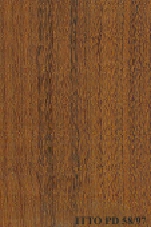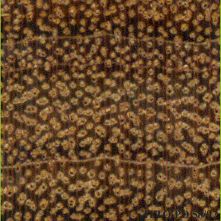
MUTENYE (Guibourtia arnoldiana)
Trade Name
Mutenye
Scientific Name
Guibourtia arnoldiana J.Leon.
Family
LEGUMINOSAE
Common Names
Tropical oliver (United Kingdom); Benzi (Congo); M'penze (Angola); Tropical oliver; Oliver walnut; Ntene; Non-eyen; M`benge; Libenge; Kouan; Kerazingo; Essingang; Bubinga; Olive walnut (United Kingdom); M`penze (Angola); Mbenge (Zaire); Mutenye (Zaire); Benge (Zaire)
Scientific Name Synonyms
Copaifera arnoldiana Th. & H. Dur.; Copaiba arnoldiana De Wild. & T. Durand; Copaiba arnoldiana De Wild. & Th. Dur.
Description Of The Tree
Botanical Description
The tree reaches a height of 50 m. The bole is generally low buttressed, and occasionally fluted, up to 20 m in length. The trunk diameter attains about 120 to 150 cm.
Natural Habitat
Guibourtia arnoldiana occurs in evergreen and deciduous forests.
Wood Identification
Anatomic Description Of Wood
Wood diffuse porous. Occasionally vessels exclusively solitary (over 90%). Tangential diameter of vessel lumina 100 to 150 micras (small). Vestured pits. Vessels per mm2 10 to 20 (abundant). Simple perforation plates. Vessel-ray pits similar to intervessel pits Axial parenchyma in marginal or in seemingly marginal bands. Paratracheal axial parenchyma scanty and/or vasicentric. Axial parenchyma lozenge-aliform. Axial parenchyma aliform. Prismatic crystals in chambered axial parenchyma cells and/or in fibers. 5 to 8 ce 4 to 10 rays per mm (medium). Rays non-storied. Larger rays more than 4 seriate. Homogeneous rays and/or sub-homogeneous rays (all ray cells procumbent). Non-septate fibers. Fibers with simple to minutely bordered pits.
-
 Wood Macro Photo Tangential Plane
Wood Macro Photo Tangential Plane
-
 Wood Micro Photo Of Transversal Section
Wood Micro Photo Of Transversal Section
Availability
Cites Status
Unrestricted
General Wood Description
Color
The sapwood is greyish white, it has a thickness of 5 to 8 cm. The heartwood is yellowish brown to brown, with dark striping or reddish tinge, it is clearly demarcated. The silver figure is fine.
COLOR INDEX (1=Black, 7=Light yellow,white)
3
Grain
Straight or slightly interlocked, sometimes with an influence on further processing operations.
Texture
Texture is usually fine to medium.
Luster
The wood surface is described as low in luster.
Natural Durability
Moderately durable to decay. Without preservative treatment, this species can be used only under risk of occasional re-humidification. It is not suited for uses with risks of permanent or long-lasting humidification. Moderately resistant to termites attack
Natural durability index (1= Very high durability, 7=Vey low durability)
3
Internal Growth Stresses
Residual stresses are reported to be absent.
Silica Content
Silica Content: It is reported to have a negligible amount of silica. Contents over 0.05% may affect wood processing. Silica Value: 0.01
Resistance To Impregnation
Difficult to treat with only a low penetration of the preservative products.
Wood Physical Properties
Basic Density or Specific Gravity (O.D. weight/vol. green) (g/cm³)
0.70
Air-dry Density (Weight and volume at 12%MC) (g/cm³)
0.79
Total shrinkage Tangential (Saturated to 0%MC) (%)
8.7
Total shrinkage Radial (Saturated to 0%MC) (%)
5.0
Drying Defects
Ease of Drying: Drying is rather slow and sometimes difficult to perform. Drying Defects: Risks of distortions. Kiln Schedules: Schedule proposed as a reference by comparison with well known species taking into account to the general technological behavior of this species.
Recommended Dry Kiln Schedule
FR-9
Dimensional stability ratio (Total Tangential Shrinkage %/Total Radial Shrinkage %)
1.7
Wood Chemical Properties
Wood Mechanical Properties
Bending Strength (MOR),12%MC (kgf/cm²)
1409
Stiffness (MOE) 12%MC (kgf/cm²)
216585
Compression parallel to fiber 12%MC (kgf/cm²)
810
Compression perpendicular to fiber 12%MC (kgf/cm²)
118
Shear strength radial 12%MC (kgf/cm²)
98
Janka hardness (side) 12%MC (kgf)
779
Janka hardness (end grain) 12%MC (kgf)
857
Workability
Sawing
Sawing of this species requires powerful equipment.
Rotary Veneer Cutting
Suitable for slicing.
Sliced Veneer
Suitable for slicing.
Blunting Effect
Moderate blunting effect; stellited blades for sawing and carbide tools for machining are advised.
Machining
It needs powerful tools for processing. Possible difficulties caused by interlocked grain are reported.
Planing
Moderately easy; tools must be cautiously sharpened.
Moulding
Moderately easy; tools must be cautiously sharpened.
Turning
30
Boring
Moderately easy; tools must be cautiously sharpened.
Mortising
Moderately easy; tools must be cautiously sharpened.
Nailing
Pre-boring is necessary.
Gluing
Glues well if basic gluing technical rules are followed.
Sanding
Easy to perform; it gives good results.
Polishing
Can be polished without surface preparation.
Steam Bending
This species can be used for steam bending.
Response To Hand Tools
Working with hand tools is difficult.
REFERENCED USES
End Uses Summary
HOUSING GENERAL, beams, joists, boards, flooring, parquet, frames, steps, panelling, fittings, FURNITURE AND CABINETS, luxury furniture, cabinets, PLYWOOD AND VENEER, Decorative veneer, TURNING, ornaments, turned furniture, cutlery, lasts, OTHER AND MUSICAL INSTRUMENTS, handicrafts
General Housing
- 10 - Silica in Timbers
Beams
- 11 - Prospect: The wood database
Joists
- 12 - Tropical timbers of the world. Part I-Tropical American Species
Boards
- 13 - Dry kiln schedules for commercial woods. Temperate and tropical. Section III. Latin American (Mexico, Central, and South America) Woods–Conventional Temperatures
Flooring
- 14 - Handbook of Hardwoods
Parquet
- 15 - Empire Timbers
Frames
- 16 - Woods of the World
Steps
- 17 - Tree Conservation Database
Paneling
- 18 - W3TROPICOS Missouri Botanical Garden
Fittings
- 19 - Silica in Timbers
Furniture Cabinets
- 21 - Tropical timbers of the world. Part III-Southeast Asian and Oceanian Species.
Furniture, Luxury
- 22 - Dry kiln schedules for commercial woods. Temperate and tropical. Section IV-Asian and Oceanian Woods
Cabinet
- 24 - Empire Timbers
Panels, Veneers
- 25 - Directory of Timber Trade Malaysia
Decorative veneer
- 28 - Ministry of Agriculture, Fisheries & Forest of Fiji
Turning
- 30 - Embassy of Honduras in Japan
Ornaments
- 31 - Embassy of Colombia in Japan
Turned Articles
- 32 - Embassy of Cote d`Ivoire in Japan
Knife Handles
- 33 - Embassy of Gabon in Japan
Lasts
- 34 - Embassy of Indonesia in Japan
Handcraft
- 66 - Maderas latinoamericanas. VII. Caracteristicas anatomicas. propiedades fisicomecanicas, de secado, y tratabilidad de la madera juvenil de Cordia alliodora (Ruiz & Pav. Oken.)
Please Provide Information To View Producer Information